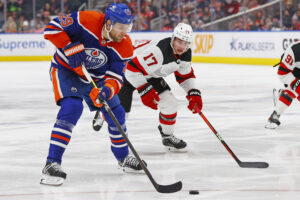This article analyzes footage of Wayne Simmonds and his performance on January 16, 2020, against the Washington Capitals. You can find a nine-minute reel of his shifts here.
Vancouver Canucks fans have been anxious since news broke on February 6, 2020, about their apparent interest in the acquisition of New Jersey Devils winger Wayne Simmonds via a trade. 6’2’’ Simmonds, once a renowned power forward with the Philadephia Flyers, has struggled mightily with the bottom-dwelling Devils this season.
As of this article’s publication, he has tallied only seven goals and twenty-three total points in fifty-seven games. Analysts have debated the benefits of bringing Simmonds to Vancouver. Look no further than his on-ice performances with the Devils, as the eye test would indicate disappointment and regret once he arrives in Vancouver.
What Wayne Simmonds Has to Offer
The Dilemma: A Declining Player and a Need For Hard-Nosed Offense
A reasonable perception has developed among analysts that Simmonds, now 31 years of age, is no longer a valuable NHL commodity, especially with his current one-year, $5 million-dollar price tag. He is certainly no longer the fearsome scorer that he once was.
The Devils are currently ranked twenty-eighth in the National Hockey League and have been offensively-challenged as a group. His personal goal production, however, began to decline three seasons ago during his time with the Flyers. His totals dipped from 31 goals in 2016-17 to 24 goals in 2017-18. He amassed only 17 goals in 2018-19 and has scored a measly seven this season. Injuries played a role. Last Word On Hockey writer Ted Brown analyzed the diminishing quality of his contributions to the Flyers in 2018. Those familiar with the Flyers’ concerns knew that Simmonds could no longer offer the type of play that had earned him past success.
Recent disturbances between the Canucks’ star forward Elias Pettersson and numerous opponents, however, have prompted panicked concerns about grit and team toughness in Vancouver. Some have expressed their belief that the team requires more toughness to deter such opposition behaviour. This is especially true with concerns about Micheal Ferland‘s health and doubts about his return to the Canucks’ lineup. Simmonds, a physical forward, has therefore been tagged as a potential candidate to be acquired.
These debates frequently elicit generalizations from both sides of the conversation. Supporters of his acquisition have cited grit and toughness as characteristics that would benefit the roster. Where detractors are concerned that he has passed his prime and is not worth his price in a trade or, for that matter, worthy of a roster position over any current Canuck forward.
Physically Strong, Competent But Mediocre Forechecker
Wayne Simmonds possesses above-average strength on the puck and is able to fend off the physical pressure of opponents in order to keep the puck on his stick. He remains capable of pushing past defenders and combating obstruction, although does not utilize his strength off the rush and does not play a timely forechecking style.
Additionally, he does not provide optimal pressure to regain puck possession for his team. The puck tends to leave the vicinity before he arrives to check his opponent. He can successfully participate in the team’s cycle and shield the puck in traffic; that said, seldom does he offer power moves or attempts to direct the puck to the net. His body of work does not stand out among the players alongside him. His time in the offensive zone is primarily spent chasing the play and shielding the puck in the corners.
A concerning element of Simmonds’ game is his choice of when to apply pressure. There are several examples in which he tried to stick check the opponent and slid away from them. He was cheating as if he expected them to relinquish control with only stick pressure. He needed to approach the puck carrier physically and eliminate their time and space. Instead, he sometimes stood a full stick lengths reach away from the carrier. One such moment of questionable gap control led to a goal against his team.
Reliance on Teammates
In the footage mentioned above, Simmonds started the match against Washington on a line with forwards Jack Hughes and Pavel Zacha but played the second and third periods with Nico Hischier in Hughes’ place. Hischier is an aggressive, tenacious, clever forechecker whose ability to shift back-and-forth along the boards frees space for himself and his teammates. Hughes, on the other hand, has not yet developed the strength or the positional wherewithal to forecheck consistently for his team in the NHL.
The difference between Hischier and Hughes permitted Simmonds greater opportunities during the game to complement the work of a shifty puck hound. The type of player with enough quickness to reach loose pucks. As well as the tenacity to resist pressure from opponents. Wayne Simmonds himself is not one of those players as he possesses sufficient straight-line speed to backcheck and join the rush, but he lacks the dynamic ability and is not elusive. Along the boards, he will pin the opponent from a standstill or provide a direct, heavy hit to jar the puck loose. However, he doesn’t provide sustained pressure or impose his will. He can protect the puck amidst pressure from the opposition, but most offensive chances result from his teammates’ actions. He is not an offensive catalyst.
An Aging Net-Front Presence in an Era Without Crease Battles
In the offensive zone, he has two preferred areas. He is most often along the corner boards, but will otherwise position himself in the low slot or crease. He regularly attempts to position himself for potential scoring opportunities around the net. His greatest attribute as a scorer has always been his proficiency in the crease. Video from his previous seasons provides ample evidence of this nearly-exclusive method of scoring from Simmonds. If a gifted playmaker spots him alone near the goalmouth, he can still score despite his dwindling goal numbers. In our featured game against Washington, he scored his fifth goal of the season after sneaking behind an oblivious defenceman in the crease and receiving a feed from Nico Hischier.
What puck skills he might have possessed in the past no longer exist to anywhere near the same degree, the norm for players of his age. His lack of one-on-one puck skills limits his options. After chipping the puck in, he will often wait for his teammates to gain possession in the corners before he engages. His lack of dynamic skill results in most entries being dump-ins and puck retrievals.
Looking in the Wrong Direction: Physical, Not Fearsome
The Vancouver Canucks seek toughness. While Simmonds offers physicality, he is not a fearsome or aggressive player. Players akin to Matthew Tkachuk and other pests are feisty, vicious and disruptive to their opponents — not Simmonds. His physical skill set has always been tailored towards offence. One shouldn’t expect him to intimidate opponents with his on-ice mannerisms.
Furthermore, the NHL has trended towards fewer crease battles over the past several seasons. Wayne Simmonds has become one of several casualties of the recently-implemented goaltender interference rules. Interference challenges, unlike offside challenges, are not penalized under any circumstances. Strict enforcement of these policies has led to the obsolescence of net-front types. Even a minuscule amount of contact can cause a goal to be reversed. Thus, skaters are more careful around the crease to ensure that their teammates’ goal-scoring efforts are not in vain.
Conclusion: Simmonds Does Not Offer What the Canucks Want
The Vancouver Canucks are built around speed and quick transitions. Precise puck movement, quickness and dynamic pressure are some characteristics that have led to the success of this year’s squad. The team actively engages in the corners and provides puck support. One of the unsung heroes of the team is power forward J.T. Miller. Miller provides speed and strength along the boards. He can dart through the neutral zone with tempo, rag the puck through open ice and create space for his teammates.
The Canucks are reaping the rewards of speed and power in such forwards as Miller and Jake Virtanen. Loui Eriksson has been able to retool his game. Although he, like Simmonds, once feasted on net-front opportunities. New rules have cleared the crease and ended the era of dominance for players of that ilk. Eriksson was 31-years-old when he joined the Canucks.
As an offensive player, Wayne Simmonds in his current form would be a downgrade from any of the team’s top-six players. He would be acceptable in a bottom-six role. However, he does not adhere to the Canucks’ aggressive, high-tempo template. The speedy, gritty Tyler Motte is an example of a player better suited for Vancouver based on his aggressive forechecking ability, skating and tenacity. Motte is currently injured and is expected to miss all of February.
Going Forward
Wayne Simmonds was a net-front menace for seven seasons in Philadelphia. The NHL now features far more speed and less crease loitering now than ever before. League-mandated changes, new league-wide trends, and an inevitable age-based decline have all but ended his time as an effective NHL scorer. If the Canucks are looking for a threatening presence to protect Pettersson, they are looking in the wrong place, If they are looking for sustained forechecking or scoring, they are almost certain to experience buyer’s remorse.
Simmonds does not pass the eye test, and teams primarily seem to covet him based on his reputation. The Canucks ought to look elsewhere for support.
Main Photo:






